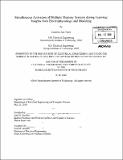Simultaneous activation of multiple memory systems during learning : insights from electrophysiology and modeling
Author(s)
Thorn, Catherine A. (Catherine Ann), 1980-
DownloadFull printable version (27.83Mb)
Other Contributors
Massachusetts Institute of Technology. Dept. of Electrical Engineering and Computer Science.
Advisor
Ann M. Graybiel.
Terms of use
Metadata
Show full item recordAbstract
Parallel cortico-basal ganglia loops are thought to give rise to a diverse set of limbic, associative and motor functions, but little is known about how these loops operate and how their neural activities evolve during learning. To address these issues, single-unit activity was recorded simultaneously in dorsolateral (sensorimotor) and dorsomedial (associative) regions of the striatum as rats learned two versions of a conditional T-maze task. The results demonstrate that contrasting patterns of activity developed in these regions during task performance, and evolved with different training-related dynamics. Oscillatory activity is thought to enable memory storage and replay, and may encourage the efficient transmission of information between brain regions. In a second set of experiments, local field potentials (LFPs) were recorded simultaneously from the dorsal striatum and the CAl field of the hippocampus, as rats engaged in spontaneous and instructed behaviors in the T-maze. Two major findings are reported. First, striatal LFPs showed prominent theta-band rhythms that were strongly modulated during behavior. Second, striatal and hippocampal theta rhythms were modulated differently during T-maze performance, and in rats that successfully learned the task, became highly coherent during the choice period. To formalize the hypothesized contributions of dorsolateral and dorsomedial striatum during T-maze learning, a computational model was developed. This model localizes a model-free reinforcement learning (RL) system to the sensorimotor cortico-basal ganglia loop and localizes a model-based RL system to a network of structures including the associative cortico-basal ganglia loop and the hippocampus. Two models of dorsomedial striatal function were investigated, both of which can account for the patterns of activation observed during T-maze training. The two models make differing predictions regarding activation of the dorsomedial striatum following lesions of the model-free system, depending on whether it serves a direct role in action selection through participation in a model-based planning system or whether it participates in arbitrating between the model-free and model-based controllers. Combined, the work presented in this thesis shows that a large network of forebrain structures is engaged during procedural learning. The results suggest that coordination across regions may be required for successful learning and/or task performance, and that the different regions may contribute to behavioral performance by performing distinct RL computations.
Description
Thesis (Ph. D.)--Massachusetts Institute of Technology, Dept. of Electrical Engineering and Computer Science, 2010. Cataloged from PDF version of thesis. Includes bibliographical references.
Date issued
2010Department
Massachusetts Institute of Technology. Department of Electrical Engineering and Computer SciencePublisher
Massachusetts Institute of Technology
Keywords
Electrical Engineering and Computer Science.